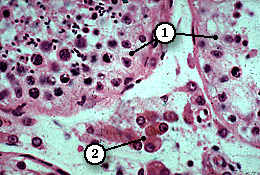 SUPPLEMENTARY: 2
SUPPLEMENTARY: 2 SUPPLEMENTARY: 2
SUPPLEMENTARY: 2
Interstitial tissue (MP) Leydig cells are large, typical steroid secreting cells which stain pink in this section. Electron microscopic studies show that they contain abundant smooth endoplasmic reticulum, storage vesicles containing cholesterol and elongated mitochondria with tubular cristae.
Testosterone production is controlled centrally by a single, hypothalamic gonadotrophic releasing hormone (GnRH). GnRH stimulates the basophils of the anterior pituitary to produce the two gonadotrophic hormones, follicle stimulating hormone (FSH) and lutenising hormone (LH). These two protein hormones control testosterone production by the Leydig cells and spermatogenesis in the seminiferous tubules. Testosterone secretion begins at puberty as a result of increasing levels of GnRH and is required for the development of secondary male sex characteristics, male behaviour and the production of fertile sperm.
| Core | Supplementary Material on Testis | |
| Return to Core | Seminiferous tubule (MP) | Interstitial tissue (MP) | Return to Male Reproductive System Main Index |